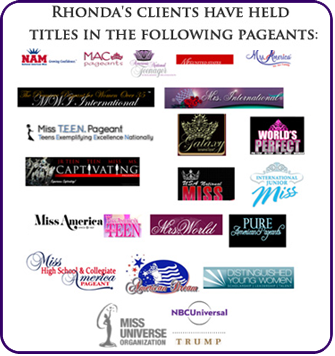In mastering the pageant interview, you need to ask the director what type of interview style the system uses. There are 5 different types of beauty pageant interview styles: one-on-one interview, panel interview, press conference style (or media) interview, on-stage questions, and talk show style. How to prepare for and have a winning pageant interview will be much easier once you know the style of interview and understand how each one is conducted.
Also, ask the director if the interview will be closed (for the judges); or done in front of the audience. Will you be standing or sitting? Will you be using a microphone? How long is the interview?
One-On-One Interview
This is a closed interview where the judges are seated at individual tables around the interview room. Contestants will enter the room in groups based on the number of judges, and you will rotate around the room in a round-robin style. Each contestant in that group is being interviewed at the same time in different spots within the room. When the time runs out, you stand up and move to the next table. For example, if there are 5 judges and each interview is 4 minutes in length, you’ll be interviewing for 20 minutes. Each interview will be different because each judge is different.
Panel Interview
Can be either a closed or open interview setting. All the judges are seated at one long table. You enter the interview space and will either sit or stand in front of the panel to answer your questions. The interview is usually 5 minutes in length, and every judge hears the same answer. Depending on how long it takes you to answer each question, every judge may not get an opportunity to ask you a question.
Press Style Conference or Media Interview
Can be conducted in a closed interview setting, but it is usually held on stage where the audience can also participate. You will stand either holding a microphone or behind a podium and answer questions from the judges and audience. Questions can be random and are asked quickly. Think of a presidential press conference and that will give you a good idea of this type of interview.
On-Stage Question
You will be onstage with the emcee. You will be asked either predetermined questions that you pull out of a bowl; or the emcee will ask you impromptu questions based on the information you wrote on your emcee card.
Talk Show Interview Style
Think Oprah, or any other talk show format, and you will know what this setting looks and feels like. The finalists are onstage as a group and sitting in chairs. The emcee will then ask each finalist a question or two. It is supposed to have a more casual, conversational feel so the contestants can express their personalities.
Pageants also have a tendency to shake things up from year to year. They may try a different style, or blend two of the styles to create a hybrid format. The more diversified and experienced you become in your interview skills; the less likely you are to be caught off guard or feel uncomfortable.
As a titleholder, you will be interviewed on stage, over the radio, on TV and for newspaper articles. Knowing how to express yourself in a concise and articulate fashion is very important. The best way to develop your Q&A skills is to practice, out loud, with an individual who can give you honest feedback and bring out your very best information.
If you want practice questions, purchase my interview cards under the resources tab.
March 30, 2011 07:22




